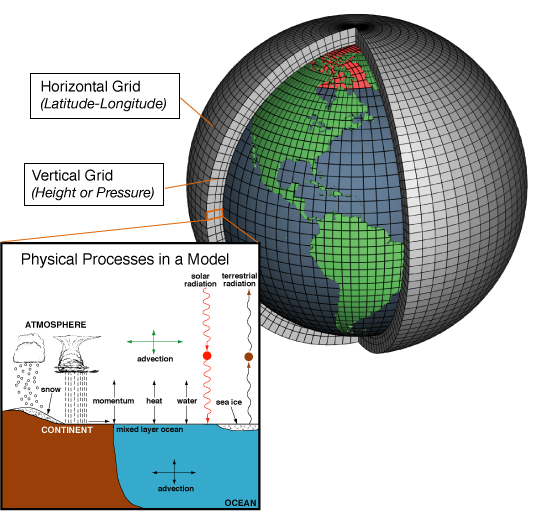

Climate Modelling
What is a climate model?
A climate model is a computer program designed to simulate Earth’s climate to understand and predict its behaviour. Climate models are largely based on a set of mathematical equations that describe the physical laws which govern the behaviour of the atmosphere and ocean and their interactions with other parts of Earth’s climate system. (e.g. land surface and ice sheets. Processes for which underlying equations are unknown or which occur at scales smaller than the grid resolution (e.g. clouds, vegetation) are represented empirically.
How are climate models run?
The mathematical equations describe how variables such as temperature, pressure, and wind change over time. These equations are solved using giant supercomputers. Observations are also used to develop the models, particularly in the testing phase. These observations come from ocean buoys, weather balloons, satellites, and instrumented commercial aircraft. When the forcing factors (e.g. intensity of the sun, concentrations of greenhouse gases, dust from volcanic eruptions) are prescribed to the model, they can be used to simulate the past and present climates and possible future climates given scenarios of future anthropogenic emissions.
The models represent Earth’s climate by dividing the surface, ocean and atmosphere into a grid; imagine each part of the Earth has its own box. In global models, the spacing (or size) of these boxes is typically in the range of 100-300 km. In regional climate models, the spacing is typically smaller; 10-50 km. For each box, the change in a variable (such as wind, temperature, or rainfall) over a specified amount of time is calculated. The time step (the amount of time between each calculation) depends on the size of the grid boxes and is usually a few minutes to about half an hour to solve the equations with sufficient accuracy. Models can be made up of millions of grid boxes and run over thousands of time steps, resulting in the simulations taking months to produce. Several simulations (an ensemble) are made for each scenario to estimate the mean climate and the uncertainty due to natural climate fluctuations.
How do climate models help us understand climate?
The climate system is very complex. Models allow us to test theories in a controlled environment. Climate models can help us predict how the climate might vary in the future. They can improve our understanding of variables such as temperature, precipitation, oceanic currents and sea ice cover. Models are also used to answer questions such as when the next El Niño weather event might occur, what might happen if greenhouse gas concentrations double, and what factors controlled Earth’s climate in the past. Simulating possible future climate change at regional and national scales for different emission scenarios is important for helping evaluate policy options.
How accurate are climate models?
Climate models are the only scientific tool with the potential for making regional predictions about future climate. We are confident that models provide helpful information because they are based on well-established physical laws and reproduce many features of the observed climate, including how it has changed in the past.
Despite robust evaluation and testing, models are not perfect. They necessarily involve approximations, particularly related to small-scale processes that cannot be simulated directly because of limited computer power and insufficient observations. How clouds are represented in climate models is a particular challenge because this involves a wide range of processes and different space and time scales. Predictions from different models are qualitatively similar on large-scale changes but differ in magnitude and regional detail. A large part of climate science involves the evaluation, improvement and testing of climate models.
Although uncertainties exist, models are unanimous that the climate has warmed and will warm further in response to increased greenhouse gases entering the atmosphere.
Listen to the Podcast:



